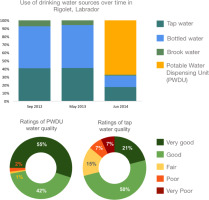Science of the Total Environment ( IF 9.8 ) Pub Date : 2017-11-10 , DOI: 10.1016/j.scitotenv.2017.10.255 Carlee J. Wright , Jan M. Sargeant , Victoria L. Edge , James D. Ford , Khosrow Farahbakhsh , Inez Shiwak , Charlie Flowers , Allan C. Gordon , Sherilee L. Harper

|
Concerns regarding the safety and aesthetic qualities of one's municipal drinking water supply are important factors influencing drinking water perceptions and consumption patterns (i.e. sources used and daily volume of consumption). In northern Canada, Inuit communities face challenges with drinking water quality, and many Inuit have reported concerns regarding the safety of their drinking water. The objectives of this research were to describe perceptions of municipal tap water, examine use of water sources and changes following the installation of a potable water dispensing unit (PWDU) in 2014, and identify factors associated with water consumption in the Inuit community of Rigolet. This study used data from three cross-sectional census surveys conducted between 2012 and 2014. Principal component analysis (PCA) was used to aggregate data from multiple variables related to perceptions of water, and logistic regressions were used to identify variables associated with water consumption patterns. Three quarters of residents reported using the PWDU after its installation, with concomitant declines reported in consumption of bottled, tap, and brook water. Negative perceptions of tap water were associated with lower odds of consuming tap water (ORPCAcomponent1 = 0.73, 95% CI 0.56–0.94; ORPCAcomponent2 = 0.67, 95% CI 0.49–0.93); women had higher odds of drinking purchased water compared to men (OR = 1.90, 95% CI 1.11–3.26). The median amount of water consumed per day was 1 L. Using brook water (OR = 2.60, 95% CI 1.22–5.56) and living in a household where no one had full-time employment (OR = 2.94, 95% CI 1.35–6.39) were associated with consuming > 2 L of water per day. Results of this study may inform drinking water interventions, risk assessments, and public health messaging in Rigolet and other Indigenous communities.
中文翻译:

与加拿大因纽特人的用水量有何关系?拉布拉多州里戈莱特的横断面调查
对一个人的城市饮用水供应的安全性和美学质量的关注是影响饮用水观念和消费模式(即使用的水源和每日消费量)的重要因素。在加拿大北部,因纽特人社区面临饮用水质量的挑战,许多因纽特人都报告了对其饮用水安全性的担忧。这项研究的目的是描述人们对市政自来水的看法,研究在2014年安装饮用水分配单元(PWDU)后对水源的使用和变化,并确定与Rigolet的因纽特人社区用水有关的因素。这项研究使用了2012年至2014年进行的三项横断面人口普查数据。主成分分析(PCA)用于汇总来自与水感知相关的多个变量的数据,逻辑回归用于识别与用水模式相关的变量。四分之三的居民表示在安装PWDU后使用了PWDU,同时瓶装,自来水和溪水的消耗量也随之下降。对自来水的否定看法与自来水的使用几率降低有关(或PCAcomponent1 = 0.73,95%CI 0.56-0.94;或PCAcomponent2 = 0.67,95%CI 0.49–0.93);与男性相比,女性饮用自来水的几率更高(OR = 1.90,95%CI 1.11–3.26)。每天消耗的水的中位数为1升。使用溪水(OR = 2.60,95%CI 1.22-5.56)并生活在没有人从事全职工作的家庭中(OR = 2.94,95%CI 1.35– 6.39)与每天消耗> 2 L的水有关。这项研究的结果可能会为Rigolet和其他土著社区的饮用水干预措施,风险评估以及公共卫生信息提供依据。



























 京公网安备 11010802027423号
京公网安备 11010802027423号